London College: Health, Safety & Wellbeing in Health & Social Care L3
VerifiedAdded on 2023/05/04
|7
|2229
|85
Report
AI Summary
This report, submitted by a London College of Professional Studies student, delves into the critical aspects of health, safety, and wellbeing within health and social care settings. It defines key concepts related to abuse, including physical, domestic violence, sexual, psychological, financial, modern slav...
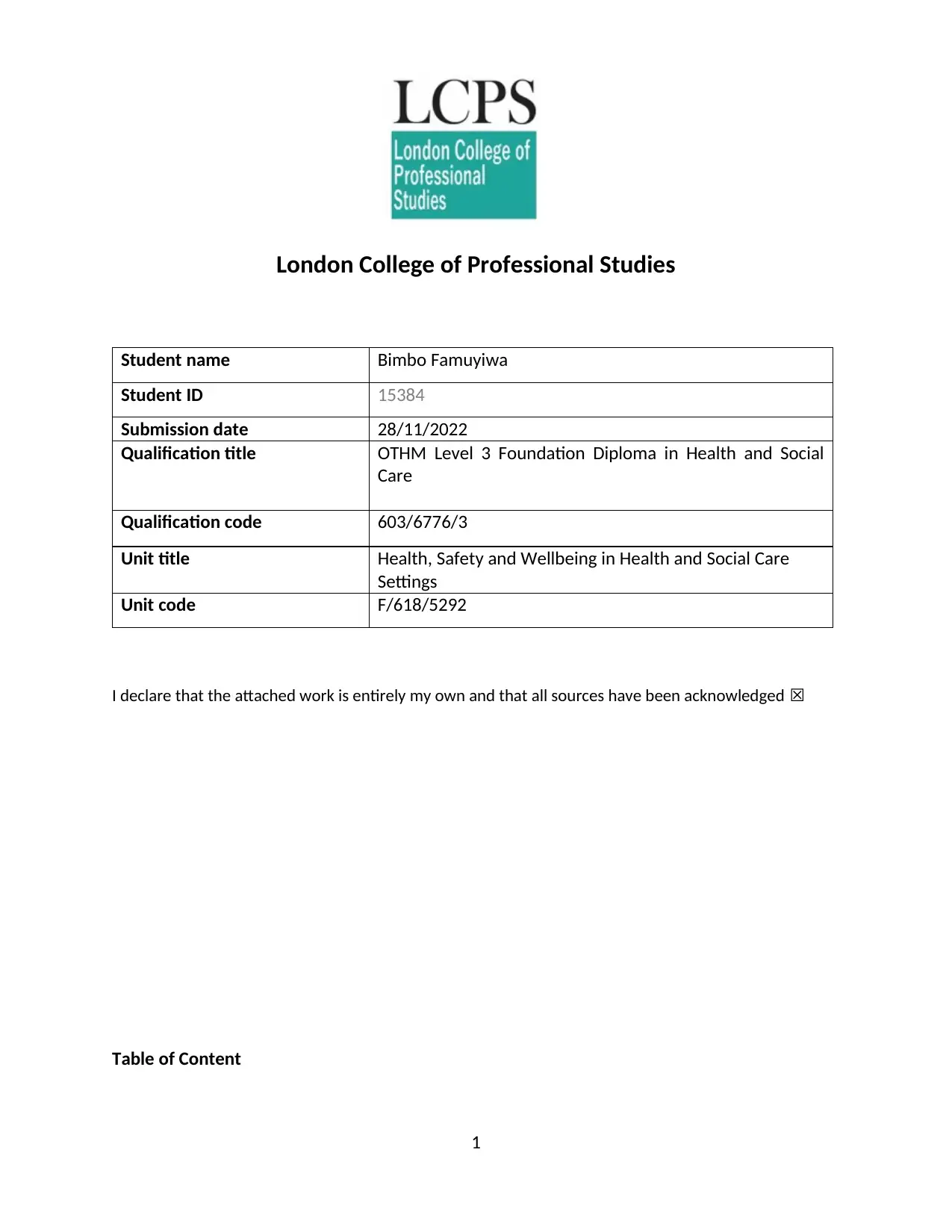
London College of Professional Studies
Student name Bimbo Famuyiwa
Student ID 15384
Submission date 28/11/2022
Qualification title OTHM Level 3 Foundation Diploma in Health and Social
Care
Qualification code 603/6776/3
Unit title Health, Safety and Wellbeing in Health and Social Care
Settings
Unit code F/618/5292
I declare that the attached work is entirely my own and that all sources have been acknowledged ☒
Table of Content
1
Student name Bimbo Famuyiwa
Student ID 15384
Submission date 28/11/2022
Qualification title OTHM Level 3 Foundation Diploma in Health and Social
Care
Qualification code 603/6776/3
Unit title Health, Safety and Wellbeing in Health and Social Care
Settings
Unit code F/618/5292
I declare that the attached work is entirely my own and that all sources have been acknowledged ☒
Table of Content
1
Paraphrase This Document
Need a fresh take? Get an instant paraphrase of this document with our AI Paraphraser
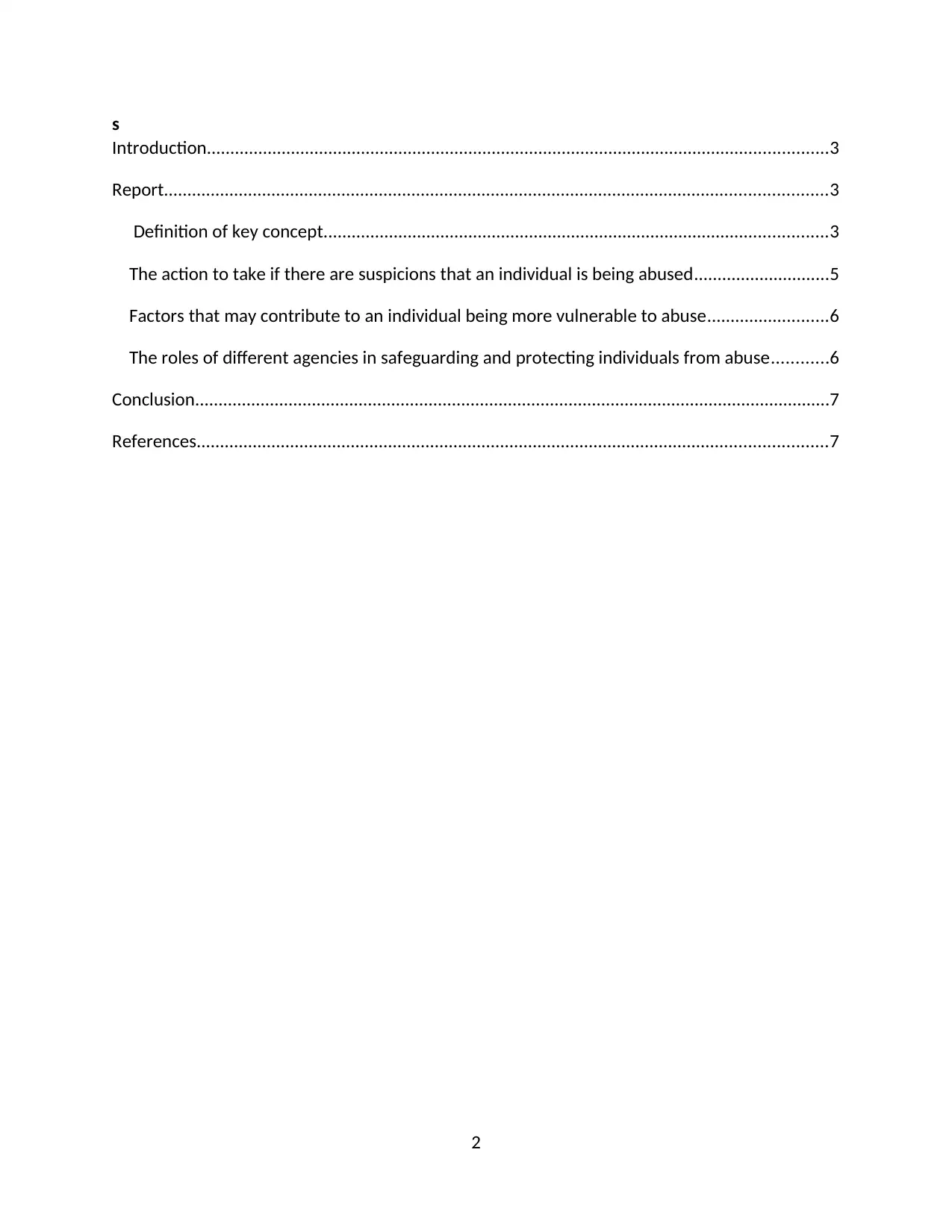
s
Introduction.....................................................................................................................................3
Report..............................................................................................................................................3
Definition of key concept............................................................................................................3
The action to take if there are suspicions that an individual is being abused.............................5
Factors that may contribute to an individual being more vulnerable to abuse..........................6
The roles of different agencies in safeguarding and protecting individuals from abuse............6
Conclusion........................................................................................................................................7
References.......................................................................................................................................7
2
Introduction.....................................................................................................................................3
Report..............................................................................................................................................3
Definition of key concept............................................................................................................3
The action to take if there are suspicions that an individual is being abused.............................5
Factors that may contribute to an individual being more vulnerable to abuse..........................6
The roles of different agencies in safeguarding and protecting individuals from abuse............6
Conclusion........................................................................................................................................7
References.......................................................................................................................................7
2
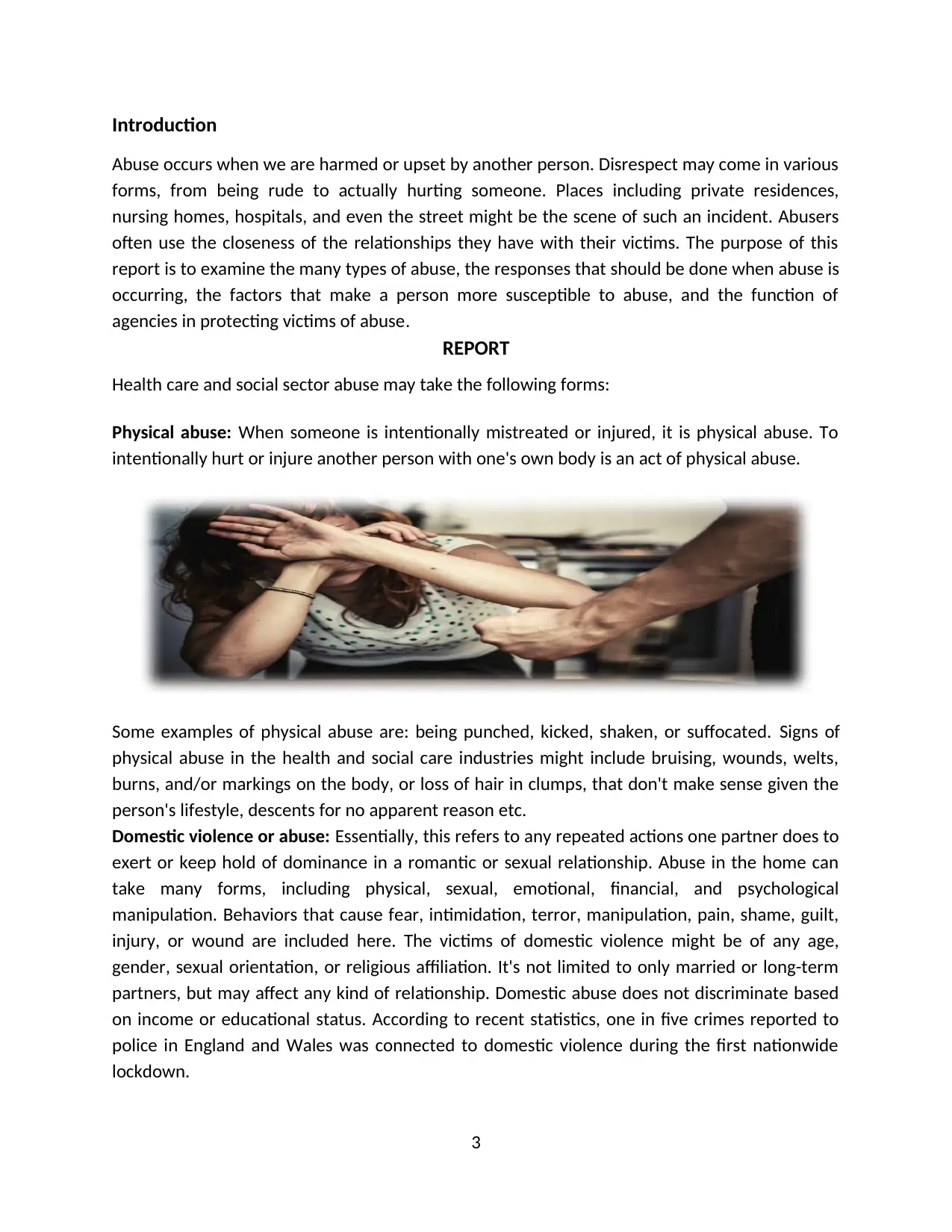
Introduction
Abuse occurs when we are harmed or upset by another person. Disrespect may come in various
forms, from being rude to actually hurting someone. Places including private residences,
nursing homes, hospitals, and even the street might be the scene of such an incident. Abusers
often use the closeness of the relationships they have with their victims. The purpose of this
report is to examine the many types of abuse, the responses that should be done when abuse is
occurring, the factors that make a person more susceptible to abuse, and the function of
agencies in protecting victims of abuse.
REPORT
Health care and social sector abuse may take the following forms:
Physical abuse: When someone is intentionally mistreated or injured, it is physical abuse. To
intentionally hurt or injure another person with one's own body is an act of physical abuse.
Some examples of physical abuse are: being punched, kicked, shaken, or suffocated. Signs of
physical abuse in the health and social care industries might include bruising, wounds, welts,
burns, and/or markings on the body, or loss of hair in clumps, that don't make sense given the
person's lifestyle, descents for no apparent reason etc.
Domestic violence or abuse: Essentially, this refers to any repeated actions one partner does to
exert or keep hold of dominance in a romantic or sexual relationship. Abuse in the home can
take many forms, including physical, sexual, emotional, financial, and psychological
manipulation. Behaviors that cause fear, intimidation, terror, manipulation, pain, shame, guilt,
injury, or wound are included here. The victims of domestic violence might be of any age,
gender, sexual orientation, or religious affiliation. It's not limited to only married or long-term
partners, but may affect any kind of relationship. Domestic abuse does not discriminate based
on income or educational status. According to recent statistics, one in five crimes reported to
police in England and Wales was connected to domestic violence during the first nationwide
lockdown.
3
Abuse occurs when we are harmed or upset by another person. Disrespect may come in various
forms, from being rude to actually hurting someone. Places including private residences,
nursing homes, hospitals, and even the street might be the scene of such an incident. Abusers
often use the closeness of the relationships they have with their victims. The purpose of this
report is to examine the many types of abuse, the responses that should be done when abuse is
occurring, the factors that make a person more susceptible to abuse, and the function of
agencies in protecting victims of abuse.
REPORT
Health care and social sector abuse may take the following forms:
Physical abuse: When someone is intentionally mistreated or injured, it is physical abuse. To
intentionally hurt or injure another person with one's own body is an act of physical abuse.
Some examples of physical abuse are: being punched, kicked, shaken, or suffocated. Signs of
physical abuse in the health and social care industries might include bruising, wounds, welts,
burns, and/or markings on the body, or loss of hair in clumps, that don't make sense given the
person's lifestyle, descents for no apparent reason etc.
Domestic violence or abuse: Essentially, this refers to any repeated actions one partner does to
exert or keep hold of dominance in a romantic or sexual relationship. Abuse in the home can
take many forms, including physical, sexual, emotional, financial, and psychological
manipulation. Behaviors that cause fear, intimidation, terror, manipulation, pain, shame, guilt,
injury, or wound are included here. The victims of domestic violence might be of any age,
gender, sexual orientation, or religious affiliation. It's not limited to only married or long-term
partners, but may affect any kind of relationship. Domestic abuse does not discriminate based
on income or educational status. According to recent statistics, one in five crimes reported to
police in England and Wales was connected to domestic violence during the first nationwide
lockdown.
3
⊘ This is a preview!⊘
Do you want full access?
Subscribe today to unlock all pages.

Trusted by 1+ million students worldwide
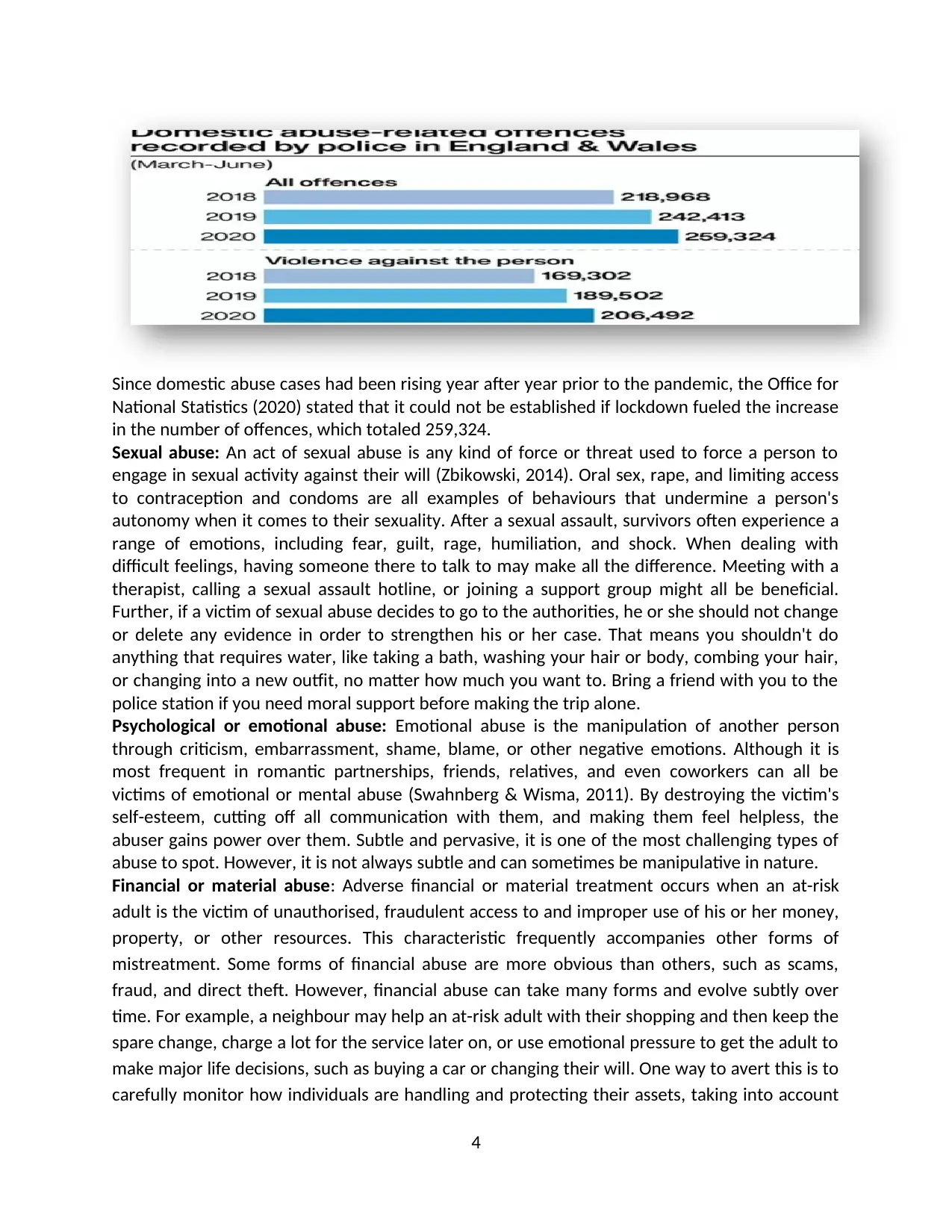
Since domestic abuse cases had been rising year after year prior to the pandemic, the Office for
National Statistics (2020) stated that it could not be established if lockdown fueled the increase
in the number of offences, which totaled 259,324.
Sexual abuse: An act of sexual abuse is any kind of force or threat used to force a person to
engage in sexual activity against their will (Zbikowski, 2014). Oral sex, rape, and limiting access
to contraception and condoms are all examples of behaviours that undermine a person's
autonomy when it comes to their sexuality. After a sexual assault, survivors often experience a
range of emotions, including fear, guilt, rage, humiliation, and shock. When dealing with
difficult feelings, having someone there to talk to may make all the difference. Meeting with a
therapist, calling a sexual assault hotline, or joining a support group might all be beneficial.
Further, if a victim of sexual abuse decides to go to the authorities, he or she should not change
or delete any evidence in order to strengthen his or her case. That means you shouldn't do
anything that requires water, like taking a bath, washing your hair or body, combing your hair,
or changing into a new outfit, no matter how much you want to. Bring a friend with you to the
police station if you need moral support before making the trip alone.
Psychological or emotional abuse: Emotional abuse is the manipulation of another person
through criticism, embarrassment, shame, blame, or other negative emotions. Although it is
most frequent in romantic partnerships, friends, relatives, and even coworkers can all be
victims of emotional or mental abuse (Swahnberg & Wisma, 2011). By destroying the victim's
self-esteem, cutting off all communication with them, and making them feel helpless, the
abuser gains power over them. Subtle and pervasive, it is one of the most challenging types of
abuse to spot. However, it is not always subtle and can sometimes be manipulative in nature.
Financial or material abuse: Adverse financial or material treatment occurs when an at-risk
adult is the victim of unauthorised, fraudulent access to and improper use of his or her money,
property, or other resources. This characteristic frequently accompanies other forms of
mistreatment. Some forms of financial abuse are more obvious than others, such as scams,
fraud, and direct theft. However, financial abuse can take many forms and evolve subtly over
time. For example, a neighbour may help an at-risk adult with their shopping and then keep the
spare change, charge a lot for the service later on, or use emotional pressure to get the adult to
make major life decisions, such as buying a car or changing their will. One way to avert this is to
carefully monitor how individuals are handling and protecting their assets, taking into account
4
National Statistics (2020) stated that it could not be established if lockdown fueled the increase
in the number of offences, which totaled 259,324.
Sexual abuse: An act of sexual abuse is any kind of force or threat used to force a person to
engage in sexual activity against their will (Zbikowski, 2014). Oral sex, rape, and limiting access
to contraception and condoms are all examples of behaviours that undermine a person's
autonomy when it comes to their sexuality. After a sexual assault, survivors often experience a
range of emotions, including fear, guilt, rage, humiliation, and shock. When dealing with
difficult feelings, having someone there to talk to may make all the difference. Meeting with a
therapist, calling a sexual assault hotline, or joining a support group might all be beneficial.
Further, if a victim of sexual abuse decides to go to the authorities, he or she should not change
or delete any evidence in order to strengthen his or her case. That means you shouldn't do
anything that requires water, like taking a bath, washing your hair or body, combing your hair,
or changing into a new outfit, no matter how much you want to. Bring a friend with you to the
police station if you need moral support before making the trip alone.
Psychological or emotional abuse: Emotional abuse is the manipulation of another person
through criticism, embarrassment, shame, blame, or other negative emotions. Although it is
most frequent in romantic partnerships, friends, relatives, and even coworkers can all be
victims of emotional or mental abuse (Swahnberg & Wisma, 2011). By destroying the victim's
self-esteem, cutting off all communication with them, and making them feel helpless, the
abuser gains power over them. Subtle and pervasive, it is one of the most challenging types of
abuse to spot. However, it is not always subtle and can sometimes be manipulative in nature.
Financial or material abuse: Adverse financial or material treatment occurs when an at-risk
adult is the victim of unauthorised, fraudulent access to and improper use of his or her money,
property, or other resources. This characteristic frequently accompanies other forms of
mistreatment. Some forms of financial abuse are more obvious than others, such as scams,
fraud, and direct theft. However, financial abuse can take many forms and evolve subtly over
time. For example, a neighbour may help an at-risk adult with their shopping and then keep the
spare change, charge a lot for the service later on, or use emotional pressure to get the adult to
make major life decisions, such as buying a car or changing their will. One way to avert this is to
carefully monitor how individuals are handling and protecting their assets, taking into account
4
Paraphrase This Document
Need a fresh take? Get an instant paraphrase of this document with our AI Paraphraser
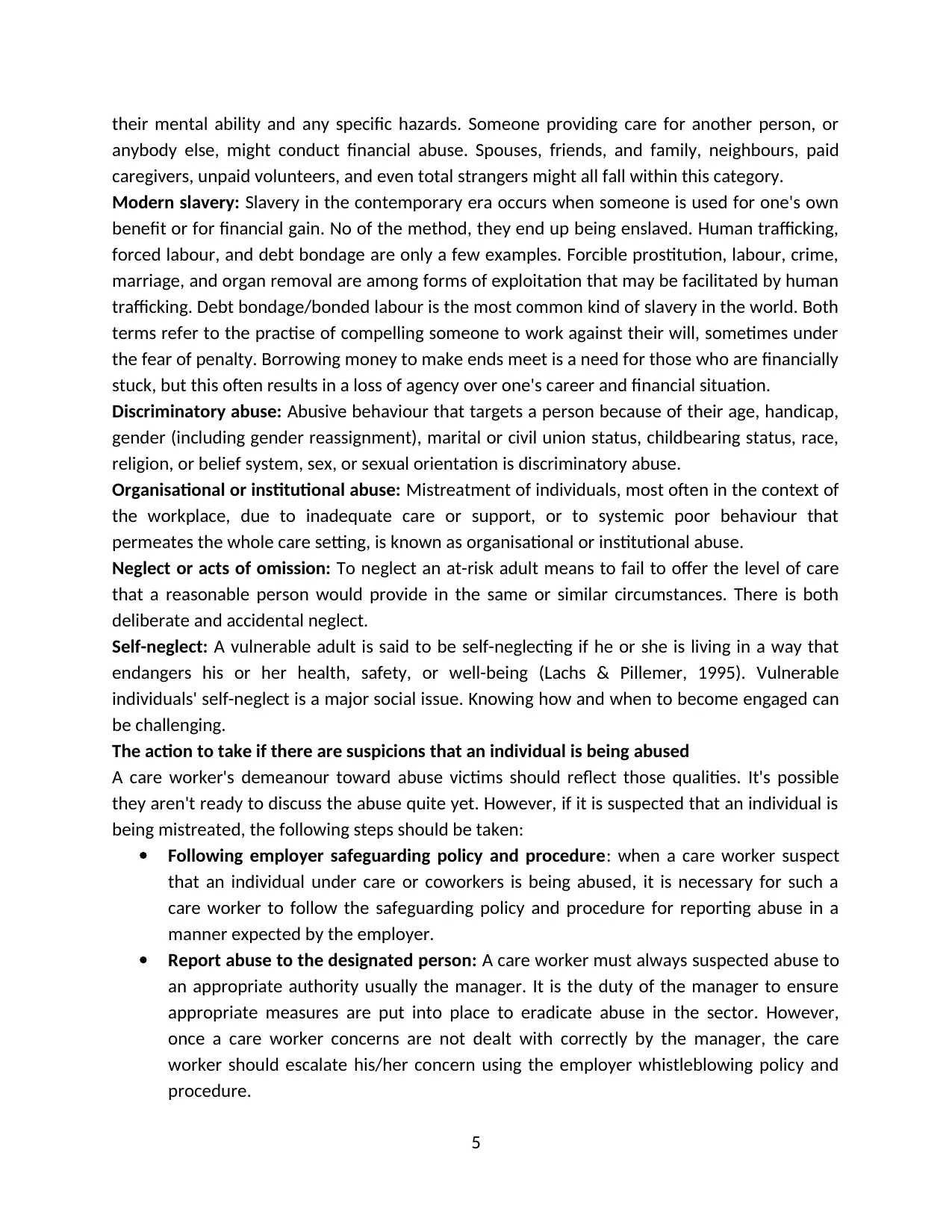
their mental ability and any specific hazards. Someone providing care for another person, or
anybody else, might conduct financial abuse. Spouses, friends, and family, neighbours, paid
caregivers, unpaid volunteers, and even total strangers might all fall within this category.
Modern slavery: Slavery in the contemporary era occurs when someone is used for one's own
benefit or for financial gain. No of the method, they end up being enslaved. Human trafficking,
forced labour, and debt bondage are only a few examples. Forcible prostitution, labour, crime,
marriage, and organ removal are among forms of exploitation that may be facilitated by human
trafficking. Debt bondage/bonded labour is the most common kind of slavery in the world. Both
terms refer to the practise of compelling someone to work against their will, sometimes under
the fear of penalty. Borrowing money to make ends meet is a need for those who are financially
stuck, but this often results in a loss of agency over one's career and financial situation.
Discriminatory abuse: Abusive behaviour that targets a person because of their age, handicap,
gender (including gender reassignment), marital or civil union status, childbearing status, race,
religion, or belief system, sex, or sexual orientation is discriminatory abuse.
Organisational or institutional abuse: Mistreatment of individuals, most often in the context of
the workplace, due to inadequate care or support, or to systemic poor behaviour that
permeates the whole care setting, is known as organisational or institutional abuse.
Neglect or acts of omission: To neglect an at-risk adult means to fail to offer the level of care
that a reasonable person would provide in the same or similar circumstances. There is both
deliberate and accidental neglect.
Self-neglect: A vulnerable adult is said to be self-neglecting if he or she is living in a way that
endangers his or her health, safety, or well-being (Lachs & Pillemer, 1995). Vulnerable
individuals' self-neglect is a major social issue. Knowing how and when to become engaged can
be challenging.
The action to take if there are suspicions that an individual is being abused
A care worker's demeanour toward abuse victims should reflect those qualities. It's possible
they aren't ready to discuss the abuse quite yet. However, if it is suspected that an individual is
being mistreated, the following steps should be taken:
Following employer safeguarding policy and procedure: when a care worker suspect
that an individual under care or coworkers is being abused, it is necessary for such a
care worker to follow the safeguarding policy and procedure for reporting abuse in a
manner expected by the employer.
Report abuse to the designated person: A care worker must always suspected abuse to
an appropriate authority usually the manager. It is the duty of the manager to ensure
appropriate measures are put into place to eradicate abuse in the sector. However,
once a care worker concerns are not dealt with correctly by the manager, the care
worker should escalate his/her concern using the employer whistleblowing policy and
procedure.
5
anybody else, might conduct financial abuse. Spouses, friends, and family, neighbours, paid
caregivers, unpaid volunteers, and even total strangers might all fall within this category.
Modern slavery: Slavery in the contemporary era occurs when someone is used for one's own
benefit or for financial gain. No of the method, they end up being enslaved. Human trafficking,
forced labour, and debt bondage are only a few examples. Forcible prostitution, labour, crime,
marriage, and organ removal are among forms of exploitation that may be facilitated by human
trafficking. Debt bondage/bonded labour is the most common kind of slavery in the world. Both
terms refer to the practise of compelling someone to work against their will, sometimes under
the fear of penalty. Borrowing money to make ends meet is a need for those who are financially
stuck, but this often results in a loss of agency over one's career and financial situation.
Discriminatory abuse: Abusive behaviour that targets a person because of their age, handicap,
gender (including gender reassignment), marital or civil union status, childbearing status, race,
religion, or belief system, sex, or sexual orientation is discriminatory abuse.
Organisational or institutional abuse: Mistreatment of individuals, most often in the context of
the workplace, due to inadequate care or support, or to systemic poor behaviour that
permeates the whole care setting, is known as organisational or institutional abuse.
Neglect or acts of omission: To neglect an at-risk adult means to fail to offer the level of care
that a reasonable person would provide in the same or similar circumstances. There is both
deliberate and accidental neglect.
Self-neglect: A vulnerable adult is said to be self-neglecting if he or she is living in a way that
endangers his or her health, safety, or well-being (Lachs & Pillemer, 1995). Vulnerable
individuals' self-neglect is a major social issue. Knowing how and when to become engaged can
be challenging.
The action to take if there are suspicions that an individual is being abused
A care worker's demeanour toward abuse victims should reflect those qualities. It's possible
they aren't ready to discuss the abuse quite yet. However, if it is suspected that an individual is
being mistreated, the following steps should be taken:
Following employer safeguarding policy and procedure: when a care worker suspect
that an individual under care or coworkers is being abused, it is necessary for such a
care worker to follow the safeguarding policy and procedure for reporting abuse in a
manner expected by the employer.
Report abuse to the designated person: A care worker must always suspected abuse to
an appropriate authority usually the manager. It is the duty of the manager to ensure
appropriate measures are put into place to eradicate abuse in the sector. However,
once a care worker concerns are not dealt with correctly by the manager, the care
worker should escalate his/her concern using the employer whistleblowing policy and
procedure.
5
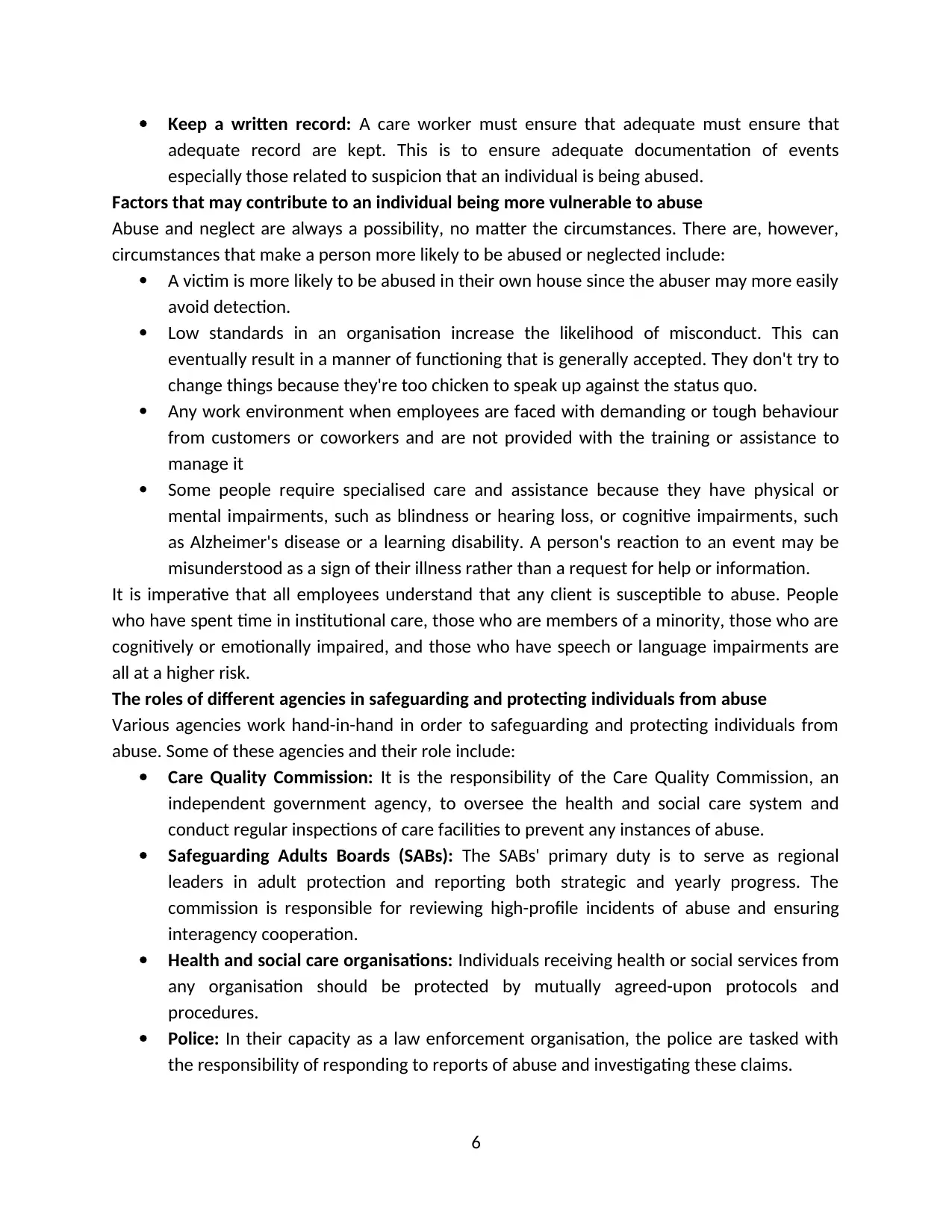
Keep a written record: A care worker must ensure that adequate must ensure that
adequate record are kept. This is to ensure adequate documentation of events
especially those related to suspicion that an individual is being abused.
Factors that may contribute to an individual being more vulnerable to abuse
Abuse and neglect are always a possibility, no matter the circumstances. There are, however,
circumstances that make a person more likely to be abused or neglected include:
A victim is more likely to be abused in their own house since the abuser may more easily
avoid detection.
Low standards in an organisation increase the likelihood of misconduct. This can
eventually result in a manner of functioning that is generally accepted. They don't try to
change things because they're too chicken to speak up against the status quo.
Any work environment when employees are faced with demanding or tough behaviour
from customers or coworkers and are not provided with the training or assistance to
manage it
Some people require specialised care and assistance because they have physical or
mental impairments, such as blindness or hearing loss, or cognitive impairments, such
as Alzheimer's disease or a learning disability. A person's reaction to an event may be
misunderstood as a sign of their illness rather than a request for help or information.
It is imperative that all employees understand that any client is susceptible to abuse. People
who have spent time in institutional care, those who are members of a minority, those who are
cognitively or emotionally impaired, and those who have speech or language impairments are
all at a higher risk.
The roles of different agencies in safeguarding and protecting individuals from abuse
Various agencies work hand-in-hand in order to safeguarding and protecting individuals from
abuse. Some of these agencies and their role include:
Care Quality Commission: It is the responsibility of the Care Quality Commission, an
independent government agency, to oversee the health and social care system and
conduct regular inspections of care facilities to prevent any instances of abuse.
Safeguarding Adults Boards (SABs): The SABs' primary duty is to serve as regional
leaders in adult protection and reporting both strategic and yearly progress. The
commission is responsible for reviewing high-profile incidents of abuse and ensuring
interagency cooperation.
Health and social care organisations: Individuals receiving health or social services from
any organisation should be protected by mutually agreed-upon protocols and
procedures.
Police: In their capacity as a law enforcement organisation, the police are tasked with
the responsibility of responding to reports of abuse and investigating these claims.
6
adequate record are kept. This is to ensure adequate documentation of events
especially those related to suspicion that an individual is being abused.
Factors that may contribute to an individual being more vulnerable to abuse
Abuse and neglect are always a possibility, no matter the circumstances. There are, however,
circumstances that make a person more likely to be abused or neglected include:
A victim is more likely to be abused in their own house since the abuser may more easily
avoid detection.
Low standards in an organisation increase the likelihood of misconduct. This can
eventually result in a manner of functioning that is generally accepted. They don't try to
change things because they're too chicken to speak up against the status quo.
Any work environment when employees are faced with demanding or tough behaviour
from customers or coworkers and are not provided with the training or assistance to
manage it
Some people require specialised care and assistance because they have physical or
mental impairments, such as blindness or hearing loss, or cognitive impairments, such
as Alzheimer's disease or a learning disability. A person's reaction to an event may be
misunderstood as a sign of their illness rather than a request for help or information.
It is imperative that all employees understand that any client is susceptible to abuse. People
who have spent time in institutional care, those who are members of a minority, those who are
cognitively or emotionally impaired, and those who have speech or language impairments are
all at a higher risk.
The roles of different agencies in safeguarding and protecting individuals from abuse
Various agencies work hand-in-hand in order to safeguarding and protecting individuals from
abuse. Some of these agencies and their role include:
Care Quality Commission: It is the responsibility of the Care Quality Commission, an
independent government agency, to oversee the health and social care system and
conduct regular inspections of care facilities to prevent any instances of abuse.
Safeguarding Adults Boards (SABs): The SABs' primary duty is to serve as regional
leaders in adult protection and reporting both strategic and yearly progress. The
commission is responsible for reviewing high-profile incidents of abuse and ensuring
interagency cooperation.
Health and social care organisations: Individuals receiving health or social services from
any organisation should be protected by mutually agreed-upon protocols and
procedures.
Police: In their capacity as a law enforcement organisation, the police are tasked with
the responsibility of responding to reports of abuse and investigating these claims.
6
⊘ This is a preview!⊘
Do you want full access?
Subscribe today to unlock all pages.

Trusted by 1+ million students worldwide
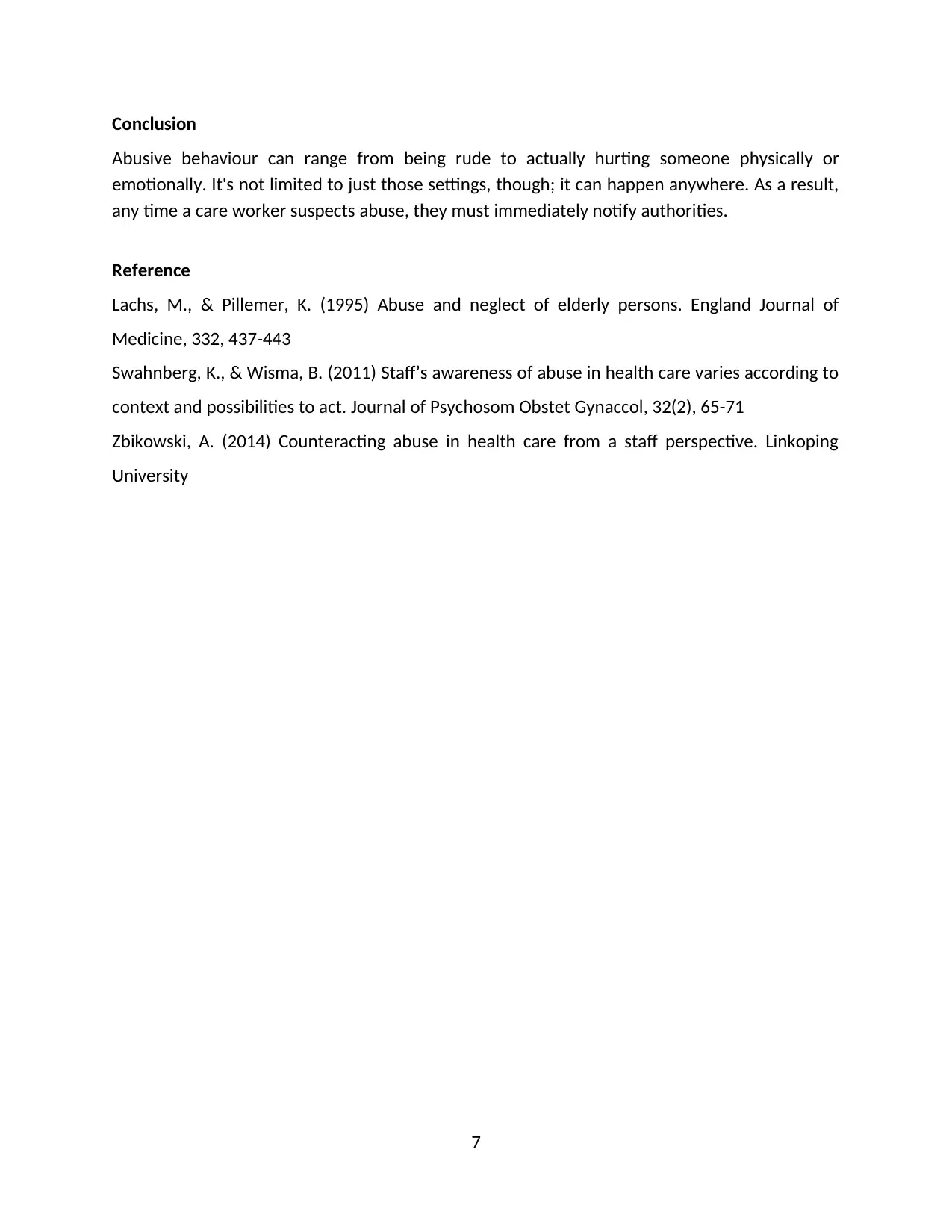
Conclusion
Abusive behaviour can range from being rude to actually hurting someone physically or
emotionally. It's not limited to just those settings, though; it can happen anywhere. As a result,
any time a care worker suspects abuse, they must immediately notify authorities.
Reference
Lachs, M., & Pillemer, K. (1995) Abuse and neglect of elderly persons. England Journal of
Medicine, 332, 437-443
Swahnberg, K., & Wisma, B. (2011) Staff’s awareness of abuse in health care varies according to
context and possibilities to act. Journal of Psychosom Obstet Gynaccol, 32(2), 65-71
Zbikowski, A. (2014) Counteracting abuse in health care from a staff perspective. Linkoping
University
7
Abusive behaviour can range from being rude to actually hurting someone physically or
emotionally. It's not limited to just those settings, though; it can happen anywhere. As a result,
any time a care worker suspects abuse, they must immediately notify authorities.
Reference
Lachs, M., & Pillemer, K. (1995) Abuse and neglect of elderly persons. England Journal of
Medicine, 332, 437-443
Swahnberg, K., & Wisma, B. (2011) Staff’s awareness of abuse in health care varies according to
context and possibilities to act. Journal of Psychosom Obstet Gynaccol, 32(2), 65-71
Zbikowski, A. (2014) Counteracting abuse in health care from a staff perspective. Linkoping
University
7
1 out of 7
Related Documents
Your All-in-One AI-Powered Toolkit for Academic Success.
+13062052269
info@desklib.com
Available 24*7 on WhatsApp / Email
![[object Object]](/_next/static/media/star-bottom.7253800d.svg)
Unlock your academic potential
© 2024 | Zucol Services PVT LTD | All rights reserved.




![Research Proposal on Domestic Violence in Jamaica, [University Name]](/_next/image/?url=https%3A%2F%2Fdesklib.com%2Fmedia%2Fimages%2Fvm%2F9409e01f7b7b4bbcab39dc5b8f65bc8f.jpg&w=256&q=75)
